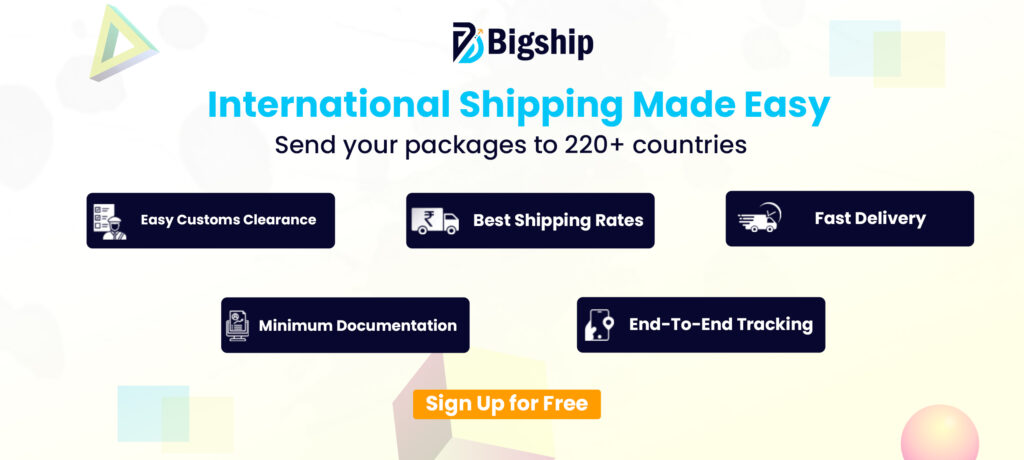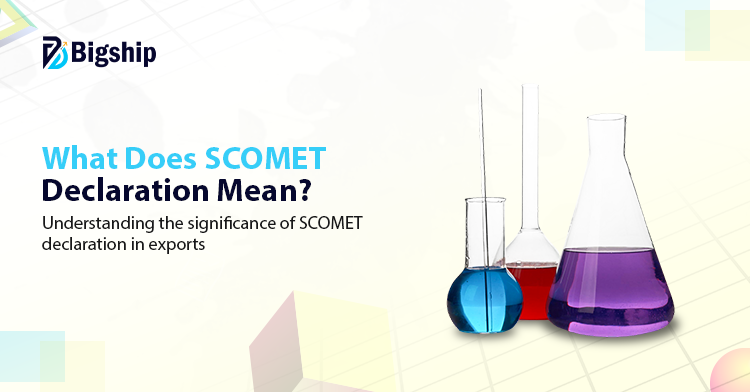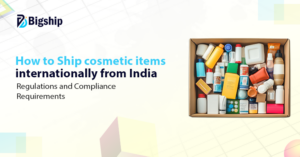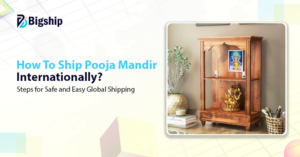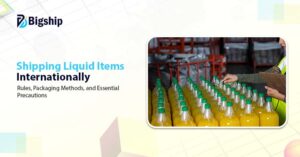Are you into exporting special items? Then you’ve probably heard of SCOMET. But what does SCOMET mean? It stands for Special Chemicals, Organisms, Materials, Equipment, and Technologies items that require strict government approval before export.
To ship these legally, businesses must follow the SCOMET declaration process, ensuring their goods aren’t misused. Missing out on compliance can lead to penalties, delays, or even bans.

Let’s understand the rules, best practices, and how to stay on the right side of SCOMET policy.
What does SCOMET mean?
SCOMET full form is Special Chemicals, Organisms, Materials, Equipment, and Technology. These are the items that have both civilian and military uses. Some of them can even be used in weapons of mass destruction. Because of this, they are considered sensitive and require strict control during exports.
If you are dealing with such goods, you must follow the rules set by the Directorate General of Foreign Trade (DGFT). This department, under the Ministry of Commerce and Industry, Government of India, manages the SCOMET list. The list has different categories based on the type and risk of the items. Following these rules ensures safe and legal exports.
What is SCOMET Declaration?
A SCOMET Declaration is a document that you must submit if you are exporting goods listed under the SCOMET category. These items are sensitive and require strict monitoring. This document ensures that the export follows all national and international security rules.
SCOMET Declaration includes details about you as the exporter, the consignee, and the final user. It also covers the item description, export purpose, required licenses, permits, technical specifications, and certifications.
This declaration is necessary to follow all export regulations. It helps prevent misuse of sensitive goods and keeps the process transparent. By submitting it, you take responsibility for ensuring that the exported items reach the right hands.
Different Categories of SCOMET Items
The SCOMET list is divided into different categories based on the type of items and their potential risks. Each category focuses on sensitive items that require careful monitoring. If you are exporting goods from any of these, you must follow the SCOMET regulations to ensure legal and safe trade. These categories are mentioned below.
Category 0: Covers nuclear materials, equipment, and technology related to nuclear use.
Category 1: Includes toxic chemicals and chemical agents that can be harmful.
Category 2: Lists micro-organisms and toxins that could pose biological risks.
Category 3: It covers different materials, processing equipment, and related technologies.
Category 4: Includes nuclear-related equipment and technology not listed under Category 0.
Category 5: Covers aerospace systems, production and test equipment, special components, and accessories.
Category 6: Deals with munitions, including weapons and military equipment.
Category 7: This category is currently kept reserved without specific items.
Category 8: Includes special materials, electronics, computers, sensors, telecommunications, navigation, aerospace, and marine technology.
SCOMET Policy and Export Rules
If you are exporting SCOMET items, you must follow strict rules to get approval. Here’s what you need to know:
- You need a license from the DGFT (Directorate General of Foreign Trade). You can apply for this through their online portal.
- Your application must include details about the items, their end-use, and the end-user.
- Different government agencies, like DGFT, the Ministry of Defence, and the Ministry of External Affairs, review your application. They ensure that your export follows national and international laws.
- The authorities might check the end-user to confirm that the items won’t be misused.
- You must follow international agreements like the Wassenaar Arrangement, the Missile Technology Control Regime, and the Chemical Weapons Convention.
- Even after shipping, you must submit post-shipment documents and compliance reports to prove that the items are being used as declared.
Steps in the Updated SCOMET Declaration Process
The updated SCOMET module has a clear process to regulate the export of sensitive items. If you are an exporter, here’s what you need to follow:
Classifying Items: First, you must check where your product falls in the SCOMET list. This helps decide the export control requirements for your goods.
Filing the SCOMET Declaration: You need to submit a SCOMET declaration with details about the item, its purpose, and the end-user. This step ensures transparency.
Getting a Licence: Authorities review your declaration and assess the risks. If everything is fine, they issue a licence. If not, you must apply again to meet the requirements.
Following Compliance Rules: Once you receive the licence, you must strictly follow its conditions to avoid misuse of the items.
Keeping Proper Records: You are required to maintain all export documents, including the SCOMET declaration format, licences, certificates, and transaction records.
Audits and Inspections: Officials may inspect your exports to ensure they are being used as declared.
Training and Awareness: You and your team must stay updated on SCOMET regulations. Proper training helps avoid compliance issues.
Who Regulates SCOMET Exports in India and its Role
As already mentioned above the Directorate General of Foreign Trade (DGFT) oversees the export of SCOMET items in India. It operates under the Ministry of Commerce and Industry and ensures that sensitive exports follow national and international security rules. If you plan to export SCOMET items, here’s how DGFT plays a role:
Setting Rules: DGFT creates and updates the Foreign Trade Policy, which includes SCOMET regulations. The SCOMET list is reviewed regularly based on global trade and security concerns.
Approving Licences: Before exporting, you must apply for a license by submitting a SCOMET declaration format with details of the items, their purpose, and the end-user. DGFT reviews this to ensure compliance.
Verifying End-Use: To prevent illegal use, DGFT checks where and how the items will be used before approving the export.
Monitoring Exports: DGFT conducts post-shipment audits and inspections to confirm that the exported items are used as declared.
Working with Global Authorities: DGFT collaborates with international bodies to strengthen export controls and global security.
How to Get a Licence for SCOMET Exports from India?
If you’re planning to export SCOMET items, you need to follow a strict approval process under SCOMET policy. The step-by-step guide to this process is given below:
Check If Your Goods Fall Under SCOMET: First, find out if your product is listed under SCOMET categories by referring to the ITC (HS) Classification of Export and Import Items. Each category has specific rules, so make sure you know where your item fits.
Get a Digital Signature Certificate (DSC): You’ll need a DSC to submit applications online. If you don’t have one then obtain it from an authorized provider.
Register on DGFT’s Portal: Create an account on the DGFT website and register your business. Make sure you have a valid Importer-Exporter Code (IEC) to proceed.
Fill Out the and Submit: Submit an online application (ANF 2N) with the detailed item description, technical specifications, End-use certificates, and purchase orders or contracts.
DGFT’s Initial Review: DGFT will conduct a preliminary check to see if all documents are in place. If anything is missing, you may be asked to provide more details.
Government Review & Security Check: Your application is then sent to multiple government bodies, such as:
- Ministry of External Affairs
- Ministry of Defence
- Indian Customs
For high-risk items, extra security clearances may also be required.
Approval Process: If your application is approved, you’ll receive an export license with conditions and validity details. In case it is rejected, DGFT will inform you of the reason.
Download the Licence: Once approved, the SCOMET export license will be available on the DGFT portal for download.
Follow License Conditions Post-License Issuance: Ensure all terms and conditions mentioned in the license are met. Maintain records of invoices, shipping documents, and compliance reports.
Submit Post-Shipment Reports: After shipping, submit the required documents to DGFT to confirm the goods were used as declared. Further, the authorities may also conduct audits to verify compliance.
What are End-User Limitations on SCOMET Exports?
When exporting SCOMET items from India, you must follow strict rules to ensure they don’t end up in the wrong hands. The end-user restrictions of SCOMET exports are mentioned below:
- If an individual, company, or country is on the denied parties list or under international sanctions, they cannot receive SCOMET items.
- The buyer must provide an End-user certification confirming how they will use the items. In some cases, on-site inspections may be required before approval.
- SCOMET items must not be used for nuclear, chemical, or biological weapons or any related activities.
- To avoid restrictions, exporters should monitor how the items are used, provide regular updates on their status, and verify end-user credentials.
- Exports must follow international non-proliferation laws and national security regulations to ensure legal use.
- Some high-risk technologies and materials require additional approvals before export.
- If an item can be repurposed for military or nuclear applications, it will be heavily restricted or outright denied.
Essential Documents for SCOMET Export Licence
The list of necessary documents required for exporting SCOMET items are mentioned below:
ANF 2N: This is the official form available on the DGFT website, filled and signed by the exporter.
Cover Letter: A formal request to DGFT mentioning the export details, items involved, and purpose.
End-User Certificate: The buyer must provide a certificate confirming the intended use of the items, their location, and an assurance of compliance with regulations.
Technical Specifications: Documents like product catalogs, technical drawings, and datasheets describing the SCOMET items.
Purchase Order & Proforma Invoice: These documents confirm the order details, quantity, pricing, and transaction terms.
Importer Exporter Code (IEC): A valid IEC issued by DGFT to identify the exporting company.
Digital Signature Certificate (DSC): A valid DSC for the authorized signatory of the company.
Previous Export Data: Details of past exports of similar items, including previous licenses and shipment records.
Declaration: A statement ensuring compliance with the SCOMET policy and explaining the purpose of export.
Importance of End User Certificate (EUC) in SCOMET Exports
When exporting SCOMET items, the End-User Certificate (EUC) is one of the most important documents. The significance of an EUC is mentioned below.
The EUC confirms that the exported items won’t be used for activities like developing weapons of mass destruction (WMDs) or other unauthorized purposes.
Authorities use the EUC to assess the legitimacy of an export before granting a license. Without it, getting approval becomes difficult.
Without an EUC, exporters risk violating national and international laws, leading to fines or even export bans.
With an EUC, authorities can trace SCOMET items from the exporter to the final recipient, ensuring proper use.
The EUC ensures that SCOMET exports comply with international non-proliferation commitments, thus preventing security threats.
A valid EUC reassures governments, regulators, and trading partners that the export is legitimate and aligns with SCOMET policy.
Consequences of Non-Compliance with SCOMET Declaration
The consequences of failing to comply with the SCOMET declaration are serious. These consequences are mentioned below.
Heavy Penalties: The severity of fines depends on the type of violation and its impact.
Imprisonment: Serious breaches can lead to legal action, including imprisonment of those responsible.
License Suspension: Export licenses may be revoked, preventing further shipments.
Blacklisting: Companies or individuals violating SCOMET regulations may be banned from future exports.
Seizure of Goods: Authorities can confiscate non-compliant items, leading to financial losses.
Government Restrictions: Non-compliant entities may be barred from participating in government contracts and projects.
How Businesses Can Stay Compliant with SCOMET Regulations?
Exporting SCOMET items comes with strict rules, and businesses need to follow the right approach to avoid penalties. Here’s how you can ensure smooth compliance with SCOMET policy.
Train Your Team Regularly: Make sure your employees understand SCOMET regulations. Regular training sessions will help them stay updated on any changes in policies.
Stay Updated with Rules Change: SCOMET rules can change over time. Keep an eye on updates from DGFT’s official website to ensure your business is always in compliance.
Set Up a Compliance Program: Have a clear compliance manual that explains how your company will handle SCOMET declarations and exports. You can conduct internal audits to make sure everything is being followed correctly.
Maintain Proper Records: Keep all documents related to your exports, including SCOMET licenses, end-user certificates, shipping papers, and approvals.
Identify and Manage Risks: Regularly assess potential risks related to exporting SCOMET items. You can develop risk mitigation plans to avoid violations.
Verify End Users Thoroughly: Before shipping SCOMET items, check your customers and end users. Make sure they are legitimate and that your goods won’t be used for unauthorized activities.
Use Technology for Compliance: Automation can help manage SCOMET compliance, record-keeping, and risk assessment. You can use compliance software to track shipments and stay organized.
Stay in Touch with Regulators: Regular communication with DGFT and other regulatory bodies can help you stay updated on new requirements and clear any doubts.
Get Third-Party Audits: Having an independent expert review your compliance process can help identify gaps and improve your systems.
Conclusion
Following the SCOMET policy isn’t just about getting approvals, it’s about ensuring exports don’t end up in the wrong hands. A mistake in the SCOMET declaration format can lead to delays, fines, or even blacklisting, making compliance essential for businesses dealing with restricted items.
At Bigship, we understand the challenges of shipping regulated goods. Whether it’s handling documentation or ensuring smooth logistics, our expertise helps businesses navigate the complexities of SCOMET policy with confidence.
Sign up with Bigship to get expert guidance on exporting SCOMET items.
FAQs
What does SCOMET mean?
SCOMET stands for Special Chemicals, Organisms, Materials, Equipment, and Technologies. It includes sensitive items that require government approval before export to ensure they are not misused.
How do I verify the end-user for a SCOMET export?
You must obtain an End-User Certificate (EUC) that confirms how the item will be used and ensures it won’t be diverted for unauthorized purposes.
What happens if I don’t follow the SCOMET policy?
Non-compliance can lead to fines, shipment seizures, blacklisting, or even imprisonment, depending on the severity of the violation.
